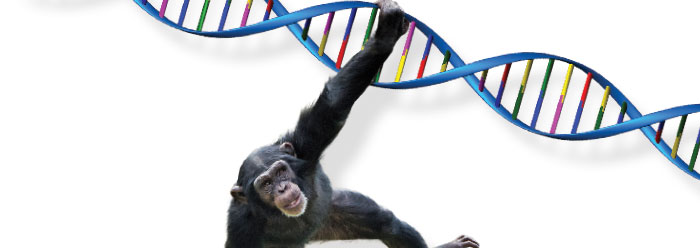Evolutionists claim that genetics has proved humans and chimpanzees are close evolutionary relatives. The current chimpanzee genome, however, was not constructed on its own merits. Instead, the human genome served as a framework for developing it. All of the short DNA sequences produced from the chimpanzee genome were assembled onto the human genome, using it as a reference sequence.1,2 This problematic shortcut was taken due to budget constraints, convenience, and a healthy dose of evolutionary presuppositions that humans evolved from apes.
Another serious potential problem with the chimpanzee genome is human DNA contamination—human sequences inadvertently included with the chimp sequences. That would also help to produce a more human-like chimpanzee genome. In 2011, a very interesting study was published in which the researchers screened 2,749 non-primate public DNA databases from all over the world and found 492 to be contaminated with human sequence—almost 18%.3 These DNA databases represented species ranging from bacteria to plants to fish. Ape and monkey databases were not tested, leaving the question open as to how much human DNA contamination may be present in them.
Given that these problems may very well have led to the development of a chimpanzee genome that appears more human-like than it actually is, ICR has initiated research to assess the quality of chimpanzee DNA sequences. This involves testing for anomalies that would indicate human DNA contamination. DNA sequence datasets that appear to have reduced levels of human DNA contamination will then be used to reassemble the chimpanzee genome in a de novo assembly, meaning that no reference genome will be used.
At present, there are 101 DNA sequence datasets available to the public that were produced using an older technology that yielded much longer chunks of DNA than current technologies, which produce a greater amount of total bulk sequence of much shorter lengths. The longer the length of the DNA sequence, the easier it is to computationally assemble into contiguous genomic regions called contigs. I downloaded all 101 of these datasets and end-trimmed the sequences to remove poor-quality bases and bacterial DNA contamination, since that type of sequencing process utilized a lab strain of the E. coli bacterium.
To ascertain the quality of each chimpanzee end-trimmed dataset, 25,000 DNA sequences were selected at random and queried against the human genome using a new version of the BLASTN algorithm. This not only checked for differences in individual bases but also allowed for small gaps in the compared sequences. When basic statistics were performed on the resulting data, it was clear that a major difference existed between the datasets for overall DNA similarity—a trend that corresponded with the timeframe in which the sequences were produced.
The initial chimpanzee genome publication was drawn from sequences produced early on in the chimpanzee genome project. These sequences were considerably more similar to human than those that were produced later in the project, by an average difference of about 5%. In fact, many datasets exhibited over a 10% difference in similarity. It may be that greater precautions against human DNA contamination were taken later in the project and thus produced less contamination. If the data from these seemingly less-contaminated sets are considered, the chimpanzee genome is no more than 86% identical to the human genome—a number that is in stark disagreement with evolution. We are now actively exploring these promising findings.
References
- The Chimpanzee Sequencing and Analysis Consortium. 2005. Initial sequence of the chimpanzee genome and comparison with the human genome. Nature. 437 (7055): 69-87.
- Tomkins, J. P. 2011. How Genomes Are Sequenced and Why It Matters: Implications for Studies in Comparative Genomics of Humans and Chimpanzees. Answers Research Journal. 4: 81-88.
- Longo, M. S., M. J. O’Neill, and R. J. O’Neill. 2011. Abundant Human DNA Contamination Identified in Non-Primate Genome Databases. PLoS ONE. 6 (2): e16410.
* Dr. Tomkins is Director of Life Sciences at the Institute for Creation Research and received his Ph.D. in genetics from Clemson University.






















